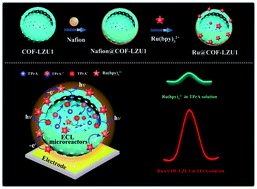Covalent organic frameworks as micro-reactors: confinement-enhanced electrochemiluminescence†
Abstract
Electrochemiluminescence (ECL) micro-reactors with enhanced intensity and extreme stability were first established by the assembly of tris(2,2′-bipyridyl) ruthenium(II) (Ru(bpy)32+) onto covalent organic frameworks (COFs), in which a type of imine-linked COF (denoted as COF-LZU1) was employed as a model for ECL micro-reactors. Compared with the dominant ECL system of Ru(bpy)32+/tri-n-propylamine (TPrA) (TPrA as a co-reactant), the intensity of the COF-LZU1 micro-reactor-based electrode was significantly increased nearly 5-fold under the same experimental conditions, which is unprecedented in other Ru(bpy)32+-based ECL systems. This enhancement can be attributed to the large surface area, delimited space, and stable and hydrophobic porous structure of COF-LZU1, which not only enabled a huge amount of Ru(bpy)32+ to be loaded in/on COF-LZU1, but also enriched a large amount of TPrA from the aqueous solution into its inner hydrophobic cavity due to the lipophilicity of TPrA. More importantly, with its hydrophobic porous nanochannels, COF-LZU1 could act as micro-reactors to provide a delimited reaction micro-environment for the electrochemical oxidation of TPrA and the survival of TPrA˙, achieving significant confinement-enhanced ECL. To prove this principle, these Ru@COF-LZU1 micro-reactors were developed to prepare an ECL aptasensor for aflatoxin M1 (AFM1) detection with a wide detection range and a low detection limit. Overall, this work is the first report in which ECL micro-reactors are constructed with COFs to enhance the intensity and stability of the Ru(bpy)32+-based ECL system, and opens a new route to the design of other ECL micro-reactors for bioanalysis applications.



 Please wait while we load your content...
Please wait while we load your content...